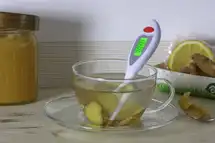What is the food temperature danger zone?
One of the most important things to remember about cooking is that food needs to be cooked to a certain temperature. In fact, if you cook your food any higher than what is recommended, there's a risk for developing bacteria and spoiling your food. The food temperature danger zone is where food can grow harmful bacteria and you want to stay away from it. Here are some simple guidelines on how to keep your food safe from bacteria while cooking.
Stay Safe in the Kitchen- Food Temperature Danger Zone and How to Avoid It
The Food Temperature Danger Zone
Everyone is concerned about Food Safety. Whether it's home-cooked food for your family or in a professional kitchen for others, all the food you prepare must be safe to consume. The temperature danger zone for food refers to the temperature range in which food is most likely to develop harmful bacteria. Anyone who handles or consumes food in the danger zone is at risk of becoming ill. Keeping food out of the danger zone limits the growth of bacteria, making it safe to eat.
The danger zone, according to food agencies, is the temperature range between 40 degrees Fahrenheit and 140 degrees Fahrenheit, which you want to keep your food away from. This means that food is safest when it is frozen, chilled, or heated above 140 F. Bacterial growth is significantly slowed at temperatures below 40 F because bacteria find it more difficult to multiply in cold temperatures. It is also important to note that freezing food does not eliminate bacteria. As a result, any defrosted food requires additional steps, such as high-temperature cooking, to ensure that it is safe to consume. Some bacteria can even multiply at temperatures as low as 25 F, so be cautious when receiving frozen deliveries.
The Main Causes of Foodborne Illness
Some of the common causes of foodborne disease are-
1. Inappropriate hot and cold food storage temperatures-
The goal of storing potentially hazardous foods at the proper temperature is to prevent pathogenic bacteria from growing. Some of the same bacteria can cause severe illnesses. Inappropriate storage of potentially hazardous foods may allow pathogenic bacteria to multiply rapidly, increasing the risk of foodborne illness. Foods that must be kept cold (refrigerated) must be preserved at 40 degrees Fahrenheit or below. Food on ice is one method of cold holding. Refrigerated trucks and walk-in coolers are other methods. The food must always be 40 F or colder.
Hazardous foods must be kept at temperatures of 135 degrees F or higher. Items like steam tables and crock pots are used to keep food warm. Operators of food facilities must take every precaution to keep potentially hazardous foods out of the Danger Zone. This includes cooling and reheating potentially dangerous foods. Hot foods must be quickly cooled before storing. That is, from 135 F to 70 F in two hours, and then from 70 F to 41 F in four hours.
2. Incorrect Food Cooking Temperatures-
Cooking food to help it reach the proper temperature is critical because raw meats naturally contain pathogenic bacteria; for example, salmonella in raw chicken. Only cooking kills bacteria. Proper storage temperatures slow reproduction. Freezing food does not kill bacteria, but it does make them dormant. When cooking, use an accurate probe thermometer to check the food's internal temperature. After reaching the proper cooking temperature, keep the food for 15 seconds to kill most, if not all the bacteria.
3. Dirty or Infected Utensils and Equipment-
Dirty or contaminated utensils or equipment can in turn contaminate food, causing foodborne illness. This can happen in various ways. If utensils or equipment are not washed regularly and old food waste is left at room temperature, bacteria can quickly multiply and contaminate the food. Food contact surfaces and food preparation equipment should be washed, rinsed, and sterilized at least every four hours.
4. Cross-contamination-
When preparing different foods, a food worker must take special care not to let uncooked animal products or anything else that raw animal products have touched come in contact with ready-to-eat foods. Contaminated utensils, food contact surfaces, leaking containers, and unwashed hands can cause cross-contamination and the growth of harmful bacteria. Care must also be taken when storing raw animal products in the fridge. It is possible for a food worker to infect customers through food. Worse, employees working with large batches of food may spread the illness to many people, causing an outbreak. Unwrapped single-use articles and exposed food must be avoided by employees with acute gastrointestinal symptoms. Wearing gloves is a must and gloves must be changed every time a food worker is required to wash their hands.
5. Unsafe Food Sources-
Any food sold, served, given away, or used as an ingredient must come from a valid source. An approved source is a facility that produces, prepares, or processes food that meets or exceeds regulatory standards. The regulatory agency may be the FDA or the USDA or any other local certified agency. When receiving food, ensure that it is received at the proper temperature, is free of vermin, and has not been altered in any way. Do not accept food that has been affected by temperature, is infested, or adulterated, for it may contain bacterial growth. In order to avoid contamination of fresh produce, always wash it before cutting, cooking, preparing, or serving.
You like to cook and bake and you want to avoid food borne illnesses.
You know the dangers of food borne illnesses, but you don’t know how to avoid them.
Common Symptoms of Foodborne Illness
Many Food Magazine and Food News websites stress upon the subject of foodborne diseases because it is a grave concern for American food safety agencies. Diarrhoea and/or vomiting are typical symptoms of foodborne illnesses that can last 17 days. (A pathogen's incubation period can range from several hours to a week.) Other symptoms include nausea, fever, joint/back pain, and fatigue.Foodborne illnesses such as stomach flu are caused by pathogens (viruses, bacteria, or parasites) in contaminated food or drink.
How to Make Sure Your Food is Safe

Food safety is the biggest challenge for any successful restaurant and it is the foremost concern to keep the food Supply Chain bacteria-free. Some of the ways food can be kept safe are-
1. Better and healthier cooking-
Avoid packaged foods. These foods are likely to have added salt, sugar, and fats. Recognize that eating these foods makes you consume a lot more salt, sugar, fats, artificial colors. The more we eat foods that have been made into something else, the less we get the polyphenols and nutrients our bodies need. Eat organic and stay healthy. Make sure to ask for allergies if your customer is a kid, an old person, or a pregnant lady.
2. Prepare food in a safe way-
Keep your food safe and free of food poisoning by following these rules-
- Make sure your kitchen staff wash their hands with hot, soapy water often. Especially after touching poultry, raw meat, fish, or eggs.
- Before you eat any fruits or vegetables, wash them.
- Separate raw, cooked, and ready-to-eat food into different groups. Keep raw meat, poultry, fish, and eggs away from other foods to prevent them from getting mixed up. Separate cutting boards could be used for these foods.
- Use a food thermometer to make sure food is cooked to a safe temperature. People who eat undercooked or raw animal products can get sick.
- When you're not sure about food, throw it away. If you unsure about how food was made, served, or stored, throw it away. Throw away food that has been out for more than two hours. Eat cooked food within four days.
3. Check your food sources and buy Fresh Produce-
Another important part of nutrition and health is food production. You can't control some of these factors. For example, if food is grown in healthy soil, it will have the trace minerals it needs.
- Check the "dirty dozen" list to see which foods have been sprayed the most. You can buy organic food for all or some of your food at a Farm Table.
- Buy meat from producers who don't use antiviral drugs.
- Make sure you don't eat fish that's high in mercury. The Hazard Analysis and EPA says that people should eat up to 12 ounces of fish that's low in mercury every week, like shrimp, canned light tuna, salmon, pollock, and catfish.
How to Practice Food Safety in the Kitchen
Every year, millions of people get sick from foodborne illnesses that mimic the flu. Food poisoning can cause serious health issues, even death. Keep your family safe by following these four steps in the kitchen-
4 Basic Food Safety Steps-
1. Clean
- Never eat or cook without washing your hands first. Wash hands for 20 seconds in warm, soapy water before and after handling food.
- Hot soapy water should be used to clean cutting boards and countertops. Do this after chopping each food item.
- Rinse produce.
- Clean the can lid before opening it.
Keep raw food separate in a dry, cool place as germs can jump from food to food.
- Garbage and eggs should be kept separate from raw meat. Use separate bags and parts of the fridge.
- Reuse raw marinades only after boiling them first.
- Set aside a raw food cutting board or plate for raw food.
Hot foods must stay hot. Heat kills germs.
Cooking to safe temps-
- Turkey, duck at 165 degrees Fahrenheit
- Ground Beef, Pork, Lamb at 160 F
- Fish at 145 degrees Fahrenheit
4. Chill
Refrigerate food immediately.
- 2-hour Rule- Refrigerate or freeze foods within two hours of cooking or purchasing. Repeat in one hour if it's 90 degrees or higher.
- Never defrost food by just taking it out of the fridge. Food thawing can be done by-
- In cold water
- Microwaving it
- Keep marinated food in the fridge
You like to cook and bake and you want to avoid food borne illnesses.
You know the dangers of food borne illnesses, but you don’t know how to avoid them.
What is the Proper Food Temperature Range for Safe Food?

Before you take your food off of the heat source, make sure that your food is hot inside. Different foods should be cooked at different temperatures- USDA says that food should be cooked at 165 F. Food will get burned if you don't stop there. Cooking ground poultry, leftover food, or food for the barbecue is done at this level of heat.
It's best to boil your eggs at 160 F to make sure they're cooked within. Ground meats, too, are cooked at 160 F. With the help of a food thermometer, keep an eye on the temperature as you grill, bake, fry, and steam food.
How to Keep Food Safe Even When You're Out
Here are five tips to help you keep your food safe at the right temperature at all points of time-
1. Adopt technology- Making probe food thermometers a part of your daily kitchen routine will help you serve properly cooked food, reduce food wastage, and create a system where managers can check food temperatures through probe thermometer apps that keeps you updated about the happenings taking place inside the kitchen even when you're away.
1. Keep an eye on the temperature- As you cook food, keep an eye on its internal temperature. This temperature should also be kept when you serve food. Check to see if you have hot plates that can reach 140 F. Otherwise, food will lose its flavor and freshness.
2. Serve the right food at the right time- Serve cold foods only when it's time, and take them out right before you serve them. You might need to keep desserts on plates over ice to keep the temperature at 4 degrees Fahrenheit. Similarly, if food is cooked then, hot foods should be kept on a hot plate before it reaches the customer.
3. Stop refills- If you have a buffet tray already set up, don't add new food to it. It brings down the food quality of freshly poured dishes. Make sure you never let food trays that are almost empty get cold, and warm them up to room temperature.
4. Keep an eye on the time- Do not keep fresh produce at room temperature for more than two hours. If they have been kept longer than that, they should be thrown away.
You just want to make a delicious meal, but you don't want to get sick.
But, how do you know what temperature your food needs to be?














































































































